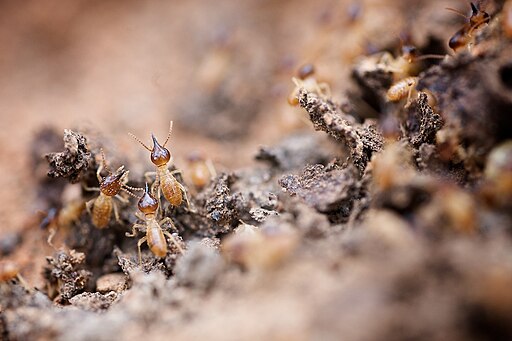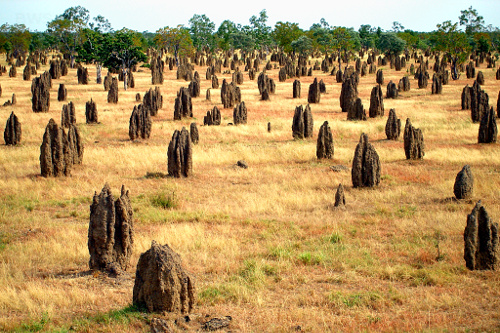27 Orders of Insects: Blattodea (Termitoidae)


Higher Taxon Termitoidae (termites)
Blattodea – Termitoidae
- common name: termites, white ants. (Greek, isos = equal; pteron = wing)
- worldwide about 2,300 species; 350 or so Australian spp with 258 described
- best represented in tropical and subtropical regions
- eusocial, live in large colonies in wood or soil
- nests: arboreal, subterranean or termitarium (a mound, plural=termitaria)
- reproductives swarm with a royal pair (king and queen) excavating a nuptial chamber, copulating and establishing a new colony; royal pair long-lived, perhaps to 50 years
- mature termite colonies may number two million individuals
- primary dietary component is cellulose; depend upon symbiotic flagellate protozoa, ameboid protozoa, bacteria or fungi for digestion
- economically significant destruction of wood and wood products
Characteristics of Blattodea-Termitoidae
Adults
- Small to medium size (<20mm); pale, elongate soft body; polymorphic
- head large or small; mandibulate mouthparts (variable in different castes), antennae long, beaded; eyes small or absent
- Wings only present in reproductive caste and shed after mating; when present, fore and hind wings usually similar with reduced venation;
- wide junction between thorax and abdomen
- abdomen terminates in segmented cerci
Immatures
- Immature stages morphologically variable (polymorphic) according to caste.

Biology
Termites are well-known for their ability to break down cellulose. This is done through their possession of gut fauna. Cellulose broken down by symbiotic bacteria (in derived groups) or flagellate protozoans (in less derived groups). These symbionts are passed to newly-moulted individuals via proctodaeal feeding, i.e. eating each others’ faeces.
Termites are eusocial so the majority of individuals are not reproductives and are allocated to a functional form called a caste. The main non-reproductive castes of termites are workers and soldiers. Soldiers are marked by their enlarged heads and mandibles and in some species they have additional protective structures. Examples include the nasute termites where the soldiers have a modified appendage on their head that ejects a toxic, glue-like secretion.
Using substrate vibration communication, soldiers bang their heads against the substrate about 11 times per second. Upon detecting the signal, in-radius soldiers propagate the warning by repeating the signal.
Keen to know more?
- Read about termite gut microbiota!
Pest status
Most termites are not pests. They play important ecological roles by recycling plant nutrients through feeding on and disintegrating and decomposing dead wood and plant debris. Excavations and nests of termites alter the structure of trees,- providing spaces used as habitat by many vertebrate species including bats, birds, reptiles and arboreal mammals.
Pest termites are grouped into three categories:
- dampwood – live in damp rotting logs or rot pockets in dead or living trees
- drywood – obtain water from wood in which they feed and have no contact with soil or other source of moisture
- subterranean – ground-dwelling or require contact with the soil or some constant source of moisture
Only 20 or so species of termites are of economic importance to timber-in-service in buildings in Australia. The risk of infestation by termites is greatest in the tropics and warm temperate coastal and inland regions. It is negligible in both Tasmania and the highlands of south-eastern Australia.
Drywood termites are widely distributed throughout coastal and adjacent tableland areas in Queensland. Most of the species of termites that damage timber-in-service in Australia are subterranean termites. Mastotermes darwiniensis and Coptotermes spp. are the most destructive e.g. Coptotermes acinaciformis is responsible for more economic loss than all the other Australian species combined. This is due to:
- its extensive range
- the severity of its attack
- its ability to survive in built-up areas such as cities and large towns
The genus Coptotermes contains several species complexes, the species within each complex differing biologically and chemically but not in appearance.
Some species of Schedorhinotermes and Nasutitermes are of economic importance – Nasutitermes exitiosus is particularly widespread in the cool temperate regions of the southern mainland states.
The annual cost of termite damage to buildings is not known, but estimates range from $80-100 million. The cost of imported chemicals may exceed $10 million annually. Surveys have been undertaken in Melbourne, Darwin, Sydney, Canberra, and Perth on the incidence of termite infestation, the location of infestations and the identity of the species involved. A Forestry Commission survey in 1982-83 indicated that 20% of houses in New South Wales had evidence of past or current termite activity. Other surveys were undertaken in Sydney, Melbourne, Adelaide and Canberra in which the incidence of recorded termite infestation in dwellings ranged from 0.9 – 4.5% per year, dependent on the city and age of the dwelling. Termites can cause significant damage with devastating financial and social implications for building owners and occupiers.
In some cases the first indication of a termite infestation is the audible sound of the termites communicating by head-drumming. Termites are good at indicating quality using sound. Termites don’t like to be exposed to drying conditions, that is why they cover their routes to maintain a micro-climate. Inspectors look for these routes around supporting house stumps or against building slabs. When they feed on timber they tend to hollow it out so that there is a paper-thin layer protecting the feeding gallery. Sometimes, the first sign of termites is hollow-sounding wood skirting, or by accidentally breaking through the thin barrier. Pest controllers tap wooden structures of a house and investigate any hollow-sounding wood by prying with a screw-driver. Bore-scopes are also useful.
Topic Review
Do you know…?
- the main anatomical features of cockroaches
- the pest status of cockroaches
- the main anatomical features of termites
- how termites impact on people

